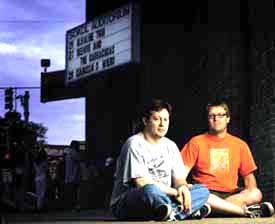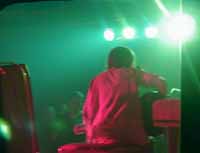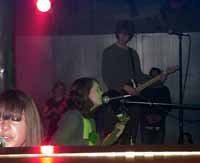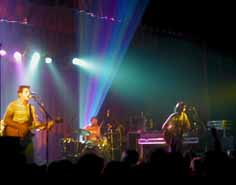|

Brought
to you by 1% Productions
How
the two unsung heroes of the Omaha music scene took their love of
beautifully obscure music and made it into a business.
story by tim mcmahan
|
|
|
Lazy-i: July 13, 2003
|
It's
a typical night at the Sokol Underground, and you can tell by the
smug, satisfied look in their eyes that the 1% Productions guys
have already started counting their money.
The
evening began with question marks that were typed months earlier
when the duo booked the band about to take the stage -- a sleepy,
slightly-depressed singer songwriter that goes by the name Cat Power.
Marc Leibowitz, the savvy, bare-knuckle fireplug of a guy who looks
like a stockier version of Kieran Culkin, was never too keen on
booking the band in the first place. The guarantee -- the amount
of money promised to the performer regardless of how many people
come to the show -- seemed too high, especially for a market like
Omaha that worships tired Freedom Rock bands, where there are no
radio stations cool enough to play a marginal, under-the-radar act
like Cat Power in the first place.
They would have passed,
except that the other half of 1% Productions, the red-haired, bespeckled
Jim Johnson, who looks like he walked off the pages of a Dan Clowes
comic, adores Cat Power and the act's sultry singer/songwriter,
Chan Marshall.
So, like most shows the
duo books, they weighed their costs, their necessary ticket price
($13, about twice the usual going rate for a show to a Sokol Underground),
considered the "cool factor" and rolled the bones.
This time the dice came
up '7.' The club, which has a posted capacity of 315, was sold out.
Stylish early 20s hipsters with their shiny black shoes and ironic
slacks stood elbow-to-elbow with indie-rock-slacker youth wearing
T-shirts bearing obscure band names and beat-up Chuck Taylors, all
lost in a fog of dirty cigarette smoke.
Sokol Underground is
little more than the basement for the much more respectable Sokol
Auditorium at 13th & Martha. With its cigarette-stained linoleum
floor, red-shaded ceiling lights and metal poles stuck in the most
inconvenient places, there is nothing interesting or attractive
about the venue. But for the arty, nonconformist youth of Omaha,
The Underground is the home of the city's indie rock explosion.
All of the nationally renowned Saddle Creek bands cut their teeth
down there. And some of indie music's most "popular" acts
have crossed its plywood stage, all brought to you by the discernable
entrepreneurial duo known as 1% Productions.
They'll be the first
to tell you that their business has little to do with making money.
They've barely broken even over the six years that they've been
operating as independent music promoters. There is nothing lucrative
about bringing critically lauded but virtually unknown, uncommercial
bands to Omaha, such as Spoon, Tristeza, Death Cab for Cutie, Mates
of State, Guided by Voices, Low, Rye Coalition, Interpol and dozens
of others that are among the most creative, most interesting, and
most unknown acts working in the music today.
"I look at this
as a paying hobby," Leibowitz says. "We take risks. We're
not making crazy money. I can't make a mortgage payment on what
I make operating 1%. We lose money some nights. But other nights
I get paid to see the bands that I love. Making a little money is
just an added benefit."
"The reason we started
this was because the bands we wanted to see weren't coming here,"
Johnson said. "And if we hadn't stepped in, they probably never
would have."
|
|
|
One
Percent got its start in October 1997. Johnson already had been
booking bands into the legendary all-ages venue The Cog Factory.
Leibowitz had just moved back to Omaha after getting a degree in
management information systems from UT Austin. The two had known
each other for years, even talked about opening their own club some
day.
Ariann Anderson, then
lead singer of the band Echo Farm, had contacted Johnson about booking
her idol, folkster Ani DiFranco, into Sokol Auditorium. Though a
known commodity in the indie world, DiFranco was far from a household
name in '97 and no one locally was willing to risk fronting her
modest guarantee.
Johnson talked it over
with Leibowitz. "Ariann had connections to do the show, but
didn't have the money," Leibowitz said. "We crunched the
numbers, talked to the people at Sokol and decided to put up the
cash ourselves."
In addition to handling
the hall and the money, Johnson and Leibowitz also took care of
the show's promotion, which consisted of posters, ads in The Reader
and word of mouth. "It also helped that Ani was on the cover
of Spin Magazine about two weeks after we signed the contract,"
Leibowitz said.
The show that no promoter
in the city would touch sold out in advance -- a feat that 1% would
never repeat. "It was a helluva way to start," Leibowitz
said. "It went off without a hitch."
But it was a short-lived
victory. The next "big" show -- a Jayhawks gig six months
later at Sokol Underground -- bombed. By then, Johnson (who was
Leibowitz's roommate) had already dropped out of 1% in an effort
to keep their friendship alive, leaving Leibowitz to suffer the
loss alone.
"When we did the
Ani show, the agent had coached us," Leibowitz said. "He
explained the contracts, the advertising, everything. The Jayhawks'
guy, who had dealt with the Ranch Bowl in the past, let me get in
over my head. When it came down to negotiations, he took the hard
line and I ended up losing $1,000 -- the biggest hit we've ever
taken. Half the profit of the Ani show paid for my loss at The Jayhawks.
Now any show where we lose money, we think of Ani."
Leibowitz survived the
Jayhawks setback and put on 22 more shows at Sokol Underground throughout
'99 and 2000, including such influential indie bands as The Dismemberment
Plan, Guided by Voices, Built to Spill, Pedro the Lion, and Saddle
Creek acts Bright Eyes, Cursive and the Faint. He was on a roll
until his dot-com job went bust and talks began surfacing about
closing Sokol Underground and turning the basement into offices.
Leibowitz got a job in
Chapel Hill, but quickly missed his old hobby, which he didn't have
a chance to pursue in North Carolina. When word came that Sokol
Underground would continue after all, he moved back to Omaha in
August 2001 and reestablished his partnership with Johnson, who
makes a living as a salesman for an auto body supply house. One
Percent Productions' second chapter began with a Wesley Willis show
Feb. 5, 2002, and the duo hasn't looked back since.
|
 
Chan
Marshall a.k.a Cat Power at Sokol Underground.
|
"We
lose money some nights. But other nights I get paid to see
the bands that I love."
|
|
|
|

The crowd
surges the merch table after
a performance at Sokol Underground.
|
"You
can put in all the effort, skill and time, but it doesn't
mean you're going to have a successful show."
|
|
|
How
have they managed to survive all these years?
They say there are three
things an independent promoter needs to survive in a business that's
littered with the busted bank accounts of well-intentioned entrepreneurs:
Connections to a club, money and knowledge if a show will draw well.
"You have to have
all three or it won't work," Leibowitz said. "You can
put in all the effort, skill and time, but it doesn't mean you're
going to have a successful show. It's a calculated risk, but if
you know about the industry, it doesn't have to be."
Let's start with the
club.
Leibowitz first forged
his relationship with the Sokol Organization with the Jayhawks debacle.
"Instead of renting the hall, I said why don't I pay you a
percentage of the door," he said. "We bargained and created
the 1% / Sokol deal."
It's a sweet deal for
the Sokol organization, which gets to keep all the bar business
taken in at the shows. Club owners will tell you that booze money
is good insurance for shows that are on the bubble of covering the
guarantee, but it's tentative insurance at best. "If you have
a show that tanks -- that draws 50 people -- you're still only going
to bring in maybe $250 in bar sales, and you still have to pay a
bartender."
From a money standpoint,
as an independent promoter, 1%'s expenses are relatively minimal
and include the band's guarantee, advertising and other promotional
costs, and any rental fees. "Yes, we're gambling on shows,
but the company is just Jim and I," Leibowitz said. "If
we owned a club, we'd get the bar money, but it's not the end all.
Clubs have mortgage payments, payroll and lots of other expenses.
If you could lose money on the door and make it up with the bar,
every bar in town would be doing live shows."
He said the decision
to do a show ultimately comes down to a break-even number based
on ticket price and attendance. The ticket price is derived from
the possible attendance, along with the band's guarantee and other
expenses. Leibowitz said contracts are drawn up with national bands
that break down the compensation between both parties beyond expenses.
It can be quite a math project.
Knowing if an artist
will draw well, however, is more of an art than a science. Although
Leibowitz and Johnson have been following music for years, they
still rely on friends in the Omaha music scene to advise them on
whether a band will draw or be a dud. "For several years, we
referred to Roger Lewis (drummer for The Good Life). Now we talk
to Chris Harding who works at (record store) Drastic Plastic, and
Eric Ziegler and Marq Manner at Homer's."
"We're getting older,"
Johnson said. "It's hard to always know what the kids are into."
A fourth key to success
is building relationships with national agents who book the bands'
tours. Though a bidding system is uses for larger touring acts,
having a relationship with an agent can help grease the skids and
get exclusive offerings. That means sometimes booking bands that
won't necessarily be profitable to get to the profitable ones, Leibowitz
said.
"For example, we've
done shows with the agent who handles Built to Spill, Imperial Teen
and Mike Watt. We knew that Imperial Teen wouldn't do well, but
we knew that they wouldn't offer the others unless we took it."
As it turned out, the
Imperial Teen show was the second-worst show 1% has ever booked,
but they made it up and then some with the other two.
|
|
| |
|
|
| |
This
is where the competition comes into play. "The Ranch Bowl would
like to take all of our shows," Leibowitz said, adding that two
recent Ranch Bowl gigs -- Vue and Small Brown Bike -- were shows 1%
would have booked.
"The Ranch Bowl
is one of the reasons why I got into this business in the first
place," Johnson said. "I went there to see Camper Van
Beethoven and was treated like shit by their Gestapo security guards."
That was years ago when
the Ranch Bowl was under different management. The club has always
insisted it's not in competition with 1% Productions.
Neither is The Music
Box. In fact, 1% and The Music Box recently joined forces to host
Luna, John Doe and God Speed You Black Emperor at the Box. The two
also are co-promoting a few upcoming shows at Sokol Auditorium,
including Big Head Todd and the Monsters July 10, and The Jayhawks
and The Thorns July 13.
J. Rankin, who runs The
Music Box, said the partnership with 1 % benefits both parties.
He turned to the duo out of necessity when seeking a venue larger
than his own club. With a capacity of 1,500, Sokol Auditorium was
a perfect option.
"Marc and Jim have
a relationship with Sokol," Rankin said. "They know the
ins and outs of the facility. There are plusses and minuses to partnering
on promoting a show. There's less money to be made, but if the show
doesn't do what it's supposed to do, the risk is minimized."
Rankin said he's never
butted heads with 1% on a potential show because the two organizations
share a similar goal. "Neither one of us meddles in the other's
business," he said. "There are shows we both might have
an interest in, but we have discussions and it comes down to what
venue makes the most sense. We're similar in that we want these
artists to come to town regardless of who's making the profit."
However, the risks are
becoming greater for 1% as it pursues more and more bigger-name
shows for Sokol Auditorium, such as their June 13 Dashboard Confessional
show that was, for the most part, a success. A lot hinges on this
month's busy auditorium schedule, which also includes Guster July
9 and Chevelle July 18.
"The break-even
number for upstairs shows is a lot higher," Leibowitz said.
"In addition, it's an all-day thing. We have to get there at
10 a.m. and help load in, get them a catered meal, be there at sound
check. It's just a much bigger deal and a lot riskier.
"Through the end
of July, we'll have had five shows in five weeks upstairs at Sokol.
If all of them tanked, 1% would be done. It's not like we have all
this money in a bank account. If we lose, it comes out of our pockets."
But one upcoming 1% auditorium
show that's a sure thing is Saddle Creek act Cursive August 10.
When interviewed by Vogue magazine recently about 1%'s role in the
booming Omaha scene, Leibowitz modestly denied the connection. "I
told him the only thing we're responsible for is Sokol being successful
and for getting the Saddle Creek bands to play somewhere other than
The Cog Factory."
But Robb Nansel, who
heads Saddle Creek Records, disagrees. "For Leibowitz to say
he had nothing to do with it is a fallacy," Nansel said. "Anyone
who's been involved with venues like Sokol Underground or The Junction
has helped build awareness about this kind of music. Marc's gone
out of his way to get quality bands like Wilco to play here -- something
that never could have been done without him. It gets everyone who
listens to music excited about what's going on here and creates
awareness for the bands and the scene.
"Independent promoters
are important and necessary for any scene. We need even more people
promoting rock shows around town."
Rankin agreed. He said
independent promoters are critical to keeping any one entity from
monopolizing the marketplace. "It's supply-and-demand economics,"
he said. "If you only had one entity providing entertainment
in this town, you'd see a whole lot of country and western bands."
You certainly wouldn't
be seeing acts like Cat Power.
In a ritual that caps
off all evenings at the Sokol, Leibowitz and Johnson disappear with
the cash till and count their takings. They pay their sound man,
pay the bands, and deposit the rest in their joint account. For
Cat Power, there wasn't much left over, but at least they didn't
lose anything and Johnson got to see one of his favorite bands.
For the last chore of
the evening, the two take their positions on the stairway leading
out of club and hand out fliers that list upcoming shows.
"We started 1% because
we wanted to start our own company," Leibowitz said. "We
wanted to do our own thing. The company's name comes from a Jane's
Addiction song and was inspired by one of their lyrics: 'I'm tired
of living the bosses' dream.' The end game is still to own a club,
but we're in no big hurry. We're doing okay."
Back to 
Published in The Omaha Weekly-Reader July 9,
2003. Copyright © 2003 Tim McMahan. All rights reserved.
|

Guster
performing at the larger Sokol Auditorium.
| |
"If
you only had one entity providing entertainment in this town,
you'd see a whole lot of country and western bands."
|
|
|
|
